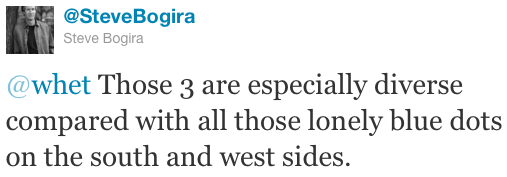Regarding my last post and the diversity of the far northeast side, my former colleague Steve Bogira responded:

After I finished the post, I noticed that Bogira just posted on segregation in Chicago over at the Reader, which he wrote about extensively earlier this year. Read it and come back; I have two notes:
1. The map of Chicago’s African-American population that accompanied Bogira’s February cover story makes a good companion to Bill Rankin’s dot map, and brings up a possible weakness in discussing segregation vis a vis blacks strictly as a race in Chicago. As you can see in both maps, Rogers Park has a substantial African-American population that’s physically blended into the neighborhood in a way that it’s not elsewhere in the city (for instance, the Humboldt Park community area has a large black population, but it’s completely—really dramatically—segregated by Grand Avenue, which divides Humboldt Park the neighborhood from Garfield Park).
But my impression, from reading and walking around, is that the diverse strip on the north side has a large African immigrant population:
Groups of refugees, such as the "lost boys" of Sudan, have built ethnic enclaves throughout Chicago, particularly in Edgewater, Rogers Park, Uptown and other North Side neighborhoods.
That’s from 2003. Here’s an article from 1993:
A large number of the city’s Haitian residents have long made their home on the South Side, as well as in Evanston. There’s also an enclave of West Indians, many of them Jamaicans, living in Evanston, many of them around the Howard Street area. Throughout the city, there are numerous Africans from the continent. Along the North Broadway business strip, there is a growing number of African-owned businesses such as bookstores, restaurants and clothing boutiques.
Ethiopians, who are among the city’s most recent African immigrants, can be found in the Uptown, Edgewater and Rogers Park areas, said Mekonnen Gessesse, publisher of Landafta, a recently launched magazine published in Amharic, the official language of Ethiopia.
So I suspect that when we’re talking about diversity on the north side and segregation on the south and west sides, we’re talking about two different communities of African-Americans, one a comparatively recent immigrant community, the other running many generations back in the city and country, with all the weight of history that implies.
2. Read the whole thing, but this jumped out at me from Bogira’s new post on segregation:
Elsewhere in the same New York Times, reporter Monica Davey observed that Daley “sees his biggest accomplishment as overcoming the racial, geographic and ethnic divisions that tore the city apart in the 1980s. ‘No more "Beirut by the lake,”’ Mr. Daley said.”
The "Beirut by the lake” label came from the political fights between white and black aldermen in the mid-1980s. That was when Harold Washington, an African-American, was mayor, a fact that troubled most of the city’s white aldermen.
This. What he said. If you really want to know about the inescapable phrase "Beirut by the Lake"—simplified version: Washington v. Vrdolyak—I recommend Gary Rivlin’s Fire on the Prairie, the definitive history of the Washington years. Rivlin’s a former Reader reporter; you can read an excerpt the Reader published here. If you’re pressed for time, I did a quick rundown on the encomiums to Daley’s racial legacy and the old Beirut on the Lake saw a few months ago.
(Speaking of Rivlin and race, you might have noticed yesterday that, in his inaugural speech, Emanuel brought up the post-MLK-assassination riots and their long-term effect on the city; on the 20th anniversary of the riots, Rivlin wrote a long piece about them.)


